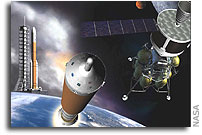NASA ESAS Final Report November 2005: Section 4.0 Lunar Architecture

 Editor’s note: DOWNLOAD THIS SECTION (PDF)
Editor’s note: DOWNLOAD THIS SECTION (PDF)
Editor’s note: several days ago we posted a final (October 2005) draft of this report. We have since come across a complete copy of the final version of the report (November 2005) which has recently been approved by NASA Administrator Michael Griffin. In order to present the most accurate version of this report, we have removed the draft version and replaced it with the final version of the report. NASA is expected to publicly release this report in early January 2006.
4. Lunar Architecture
4.1 Summary and Recommendations
As defined by the Exploration Systems Architecture Study (ESAS), the lunar architecture is a combination of the lunar “mission mode,” the assignment of functionality to flight elements, and the definition of the activities to be performed on the lunar surface. The trade space for the lunar “mission mode,” or approach to performing the crewed lunar missions, was limited to the cislunar space and Earth-orbital staging locations, the lunar surface activities duration and location, and the lunar abort/return strategies. The lunar mission mode analysis is detailed in Section 4.2, Lunar Mission Mode. Surface activities, including those performed on sortie- and outpost-duration missions, are detailed in Section 4.3, Lunar Surface Activities, along with a discussion of the deployment of the outpost itself.
The mission mode analysis was built around a matrix of lunar- and Earth-staging nodes. Lunar-staging locations initially considered included the Earth-Moon L1 libration point, Low Lunar Orbit (LLO), and the lunar surface. Earth-orbital staging locations considered included due-east Low Earth Orbits (LEOs), higher-inclination International Space Station (ISS) orbits, and raised apogee High Earth Orbits (HEOs). Cases that lack staging nodes (i.e., “direct” missions) in space and at Earth were also considered.
This study addressed lunar surface duration and location variables (including latitude, longitude, and surface stay-time) and made an effort to preserve the option for full global landing site access. Abort strategies were also considered from the lunar vicinity. “Anytime return” from the lunar surface is a desirable option that was analyzed along with options for orbital and surface loiter. The duration, location, and centralization of lunar surface activities were analyzed by first determining the content of the science, resource utilization, Mars-forward technology demonstrations, and operational tests that could be performed during the lunar missions. The study team looked at high-priority landing sites and chose a reference site in order to further investigate the operations at a permanent outpost. With the scientific and engineering activities defined, concept-level approaches for the deployment and buildup of the outpost were created. A comprehensive definition of lunar surface elements and infrastructure was not performed because development activities for lunar surface elements are still years in the future. Therefore, the ESAS team concentrated its recommendations on those elements that had the greatest impact on near-term decisions.
The mission architecture decisions that most greatly affect near-term NASA development activities are mission mode, propulsion system types, and mission duration. The ESAS team recommends the use of an Earth Orbit Rendezvous-Lunar Orbit Rendezvous (EOR–LOR) mission mode. This mission mode, which can be executed with a combination of the launch of separate crew and cargo vehicles, was found to result in a Low Life Cycle Cost (LCC) and the highest crew safety and mission reliability combination. Further, the study found that pressure-fed Liquid Oxygen (LOX)/methane propulsion should be used for the lander ascent stage as well as the Crew Exploration Vehicle (CEV) Service Module (SM), which should be sized to perform the Trans-Earth Injection (TEI) propulsive maneuver for a lunar mission. The study also concluded that the lunar lander should use a LOX/hydrogen throttleable propulsion system for Lunar Orbit Insertion (LOI) and landing. The two-stage lander should include an airlock and be sized to support a 7-day surface mission with four crew members.
Table of Contents
This large 50 MB PDF report has been subdivided into 17 PDF files – one for each of the report’s 17 sections. Click on the link at the top of each section to visit a summary page and to download that section.
Editor’s note: several days ago we posted a final (October 2005) draft of this report. We have since come across a complete copy of the final version of the report (November 2005) which has recently been approved by NASA Administrator Michael Griffin. In order to present the most accurate version of this report, we have removed the draft version and replaced it with the final version of the report. NASA is expected to publicly release this report in early January 2006.
- 1. Executive Summary
- 2. Introduction
- 3. Ground Rules and Assumptions
- 4. Lunar Architecture
- 5. Crew Exploration Vehicle
- 6. Launch Vehicles and Earth Departure Stages
- 7. Operations
- 8. Risk and Reliability
- 9. Technology Assessment
- 10. Test and Evaluation
- 11. Integrated Master Schedule
- 12. Cost
- 13. Summary and Recommendations
- 14. Architecture Roadmap
- 15. Architecture Advantages
- 16. ESAS Core Team Members
- 17. Acronyms and Abbreviations








